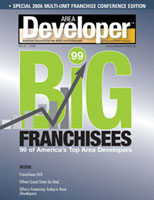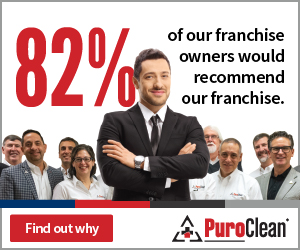Looking for a Few Good Metrics
When a franchise deal becomes large enough to attract the interest of venture capital and private equity firms, it almost always involves buying franchisors, not investing in franchisees. But that picture is changing as 1) multi-unit franchisees and area developers continue to grow larger, and 2) the money available for investing at the private equity level continues to pile up.
Craig Donaldson, president of Harris Research, franchisor of Chem-Dry and N-Hance (Revolutionary Wood Renewal), is in an interesting position these days. On January 9, Home Depot announced it had purchased the franchisor from Nautic Partners, a private equity firm. Nautic had purchased the company in 2002 from Summit Partners, another private equity firm, which invested in Chem-Dry in 1996.
While he is careful to qualify his observations as coming from the franchisor side, Donaldson says that when venture capital or private equity firms consider investments in the franchise industry, they are looking primarily at four metrics:
- stable, predictable, consistent cash flow
- growth opportunities
- solid management team
- sustainable, strong competitive position.
All these metrics apply 100 percent to multi-unit operators and area developers seeking to fund expansion or sell their operation.
"Right now there are a lot of companies like Nautic and Summit that have money to invest, and they're looking for good, strong, cash flow businesses," says Donaldson. "When a lot of dollars are chasing a few good quality deals, it leads to some good transactions for the sellers."
Points of Interest
Entering 2006, lenders may be a little more leery in 2006 than in the past few years, says Rick Anderson, general manager of franchising at Franchise Finance. With the federal funds rate settled in at a 40-year low of 1 percent from mid-2003 until mid-2004, money became more available than it had been in decades.
Since then, the rate has risen 14 times, to 4.5 percent as of January 31, affecting not only new borrowers, but those with existing loans as well. SBA lending usually follows the Fed, and before the rates started rising, franchisees could get SBA loans at about 6 percent, he says. Today those loans are more likely to be in the 10 percent range.
"The concern with lenders right now is, can the people who were on those loans--and a lot of them are floating rates--afford to keep making their debt service payment with double the interest?" he says. "It's not so much that the rates are 'high-high,' but that people who got in the business when the rates were lower have to adjust. If you're making the same gross and keep spending the same amount, and your monthly payment starts going up and up, if you don't adjust somewhere, you can get upside down."
Another factor tightening credit is a growing number of defaults, says Anderson. "I think the SBA and lenders have been burned a little bit. A few lenders have had some pretty big operators that went into default."
What's the outlook for 2006? Anderson says the experts are forecasting a "neutral" interest rate--meaning the Fed is neither trying to stimulate nor slow the economy. If they're right, rates should hold fairly steady this year.
As for his company, "We did get a lot of business after 9/11. Rates dropped, it was hard times, and people were getting laid off left and right. We had a little bit of a boom from '01 to about '04, and part of '05. But what we're seeing now is a slowdown of at least 20 to 25 percent of new startup franchisees. The way we measure that is by applications that come in the door."
One reason is a bit of sticker shock resulting from today's rates. "There are a lot of wait-and-see people out there now in business. Our feeling is rates are not going to come down. They're going to stay here for a while, maybe go up a little, maybe come down a little. But they're not going to go back down to post-9/11."
Mezzanine Financing
The role of mezzanine lending has changed in recent years, making it a more viable funding option for large franchisees as they consider further expansion. Originally intended as a bridge to help a company on the road to an IPO, mezzanine financing now is more apt to be a longer-term relationship.
"When these loans first came out, it was assumed the mezzanine lender would not be there for a very long time, that you were going to go to an IPO. Now it's very common for a mezzanine lender to have a loan for seven years," says Jeff Rosenfeld, managing partner at Kessev Finance.
Since mezzanine players are not looking for the "home run" return on investment private equity firms swing for, they usually are a less expensive way for a franchisee to finance growth. "If you can use mezzanine rather than equity, you're a lot better off," says Rosenfeld. Mezzanine players have a lower risk-return profile than private equity firms, which translates into cheaper money for borrowers.
"When a good franchisee or area developer buys up other stores, the risk on that should be fairly low and the mezzanine player should love it," says Rosenfeld. And there is always the upside that the company will be purchased, in whole or in part, providing several ways for the lender to exit the transaction. These include: 1) someone buying the franchisee's company outright; and 2) breaking the stores apart and selling them to other franchisees within the system, back to the franchisor, or to a franchisee of another system seeking to add a new brand or market. While mezzanine lenders generally discount the possibility of their investment going public, these possibilities make investing in a multi-unit operator appealing to them.
"If something good happens, they could get a much higher return than what they normally want. If it just goes according to plan, the risk they take for the return they're getting is still very good for them," he says. "Sometimes the smaller parts are worth more than the whole, and the amount they have to pay is kind of in the home run range for a mezzanine player," says Rosenfeld. And for the multi-unit franchisee, too.
Information System, Please
When lenders and investors evaluate franchisees, one thing that makes them feel less uncomfortable about parting with their money is knowing that the borrower has a good information system. Whether for a first unit, a tenth, or a hundredth, they like to be sure that the franchisee know what's going on in each unit every moment of the day.
"Say you have 10 units and you want to buy another 10," says John Rosenfeld, managing partner at Kessev Finance. "A good lender will ask you, 'How are you going to manage 20 stores?' At some point you get to a level that you can't see all your stores in the same day. Whatever level that is, you have to rely upon somebody else sending you information."
For his evaluation purposes, seeing a good information system in place is a strong positive. "If you don't have a computer system or some automated way of seeing what's happening in all your 20 stores by pushing a button, I might not find that as attractive a deal to do as if you have a button you can push and get all 20 stores and cut the data all kinds of different ways," says Rosenfeld.
"If I'm a mezzanine financer I'm probably seeing at least 500 transactions a year, maybe a thousand. A great screening technique is: if somebody wants to run a $20 million business without a computerized, automated system, forget it. That's a recipe for disaster," he says.
"I've been doing this for a while, and I've done a lot of different transactions," says Rosenfeld. "I'm looking for a great management team that wants to be the dominant company in their marketplace--and it turns out that most of those dominant companies have good systems. If you don't have these systems, you can be a dominant player in terms of market share, but you won't make as much money as somebody who has them."
If you begin with the end in mind, he says, start by building a computer model from day one to allow you to have the operating metrics from all your stores (if the franchisor doesn't have one for you). Once you're up and running, it's much harder to go back and retrofit a system. And it could be too late.
Share this Feature
Recommended Reading:
FRANCHISE TOPICS
- Multi-Unit Franchising
- Get Started in Franchising
- Franchise Growth
- Franchise Operations
- Open New Units
- Franchise Leadership
- Franchise Marketing
- Technology
- Franchise Law
- Franchise Awards
- Franchise Rankings
- Franchise Trends
- Franchise Development
- Featured Franchise Stories
FEATURED IN

Multi-Unit Franchisee Magazine: Issue 1, 2006

$200,000
$250,000





 The multi-unit franchise opportunities listed above are not related to or endorsed by Multi-Unit Franchisee or Franchise Update Media Group. We are not engaged in, supporting, or endorsing any specific franchise, business opportunity, company or individual. No statement in this site is to be construed as a recommendation. We encourage prospective franchise buyers to perform extensive due diligence when considering a franchise opportunity.
The multi-unit franchise opportunities listed above are not related to or endorsed by Multi-Unit Franchisee or Franchise Update Media Group. We are not engaged in, supporting, or endorsing any specific franchise, business opportunity, company or individual. No statement in this site is to be construed as a recommendation. We encourage prospective franchise buyers to perform extensive due diligence when considering a franchise opportunity.